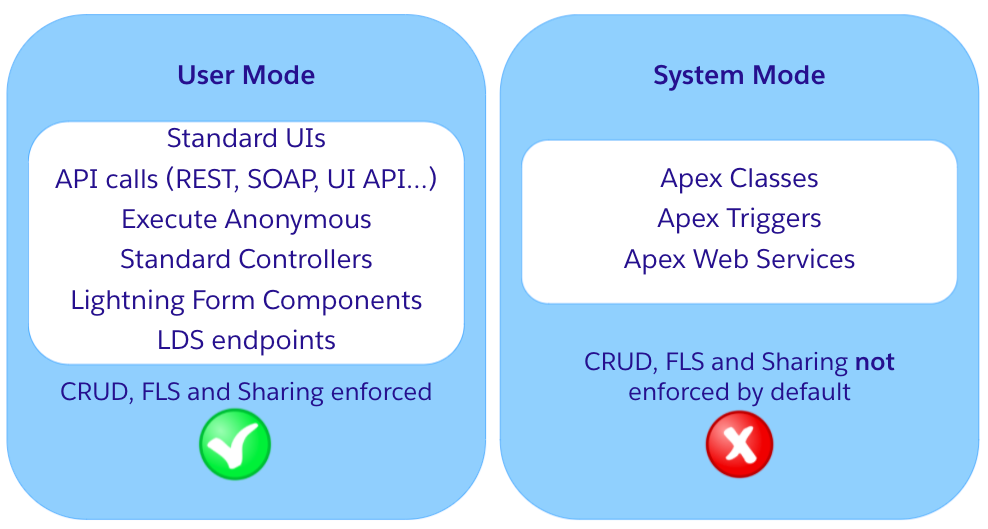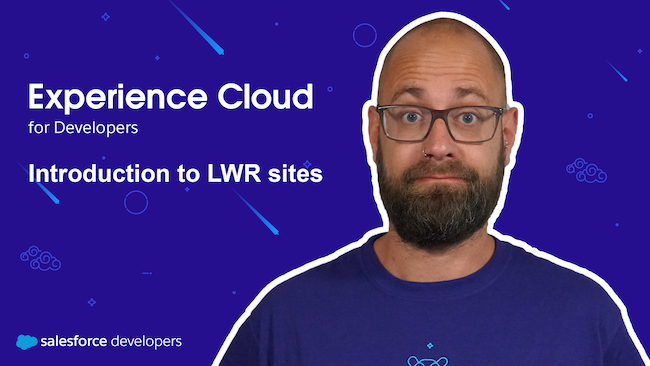Security for Salesforce Developers

These security layers are configured through several tools, such as permission sets, organization-wide defaults, or sharing rules. If you’re a solo developer or someone on a small team, you may configure these yourself. But if you’re on a larger team, it’s likely that you won’t. However, in both cases, you’ll probably write code. Therefore, it’s extremely important that you understand how application code runs in regards to data security, and how to enforce the different data security mechanisms when they’re not enforced by default.
Basically, operations in Salesforce can run in two modes: User Mode, where data security is enforced, and System Mode, where it isn’t. Operations through entry points as the standard UI (standard Salesforce record pages), and standard API endpoints run in User Mode. Components and services that are used to build user interfaces also run in User Mode. These can be record-form Lightning Components or LDS (Lightning Data Service) endpoints.
How to Build LWR Sites with Experience Cloud

In Experience Cloud, you can use a variety of pre-built templates that give you a lot of out-of-the-box functionality. With the Build Your Own (LWR) template, on the other hand, you have to build (mostly) everything from scratch. So why would you want to use it?
First, you get great performance for all your users, no matter whether they work remotely in Australia or in an office in Ohio. This is because with LWR we’re following a Jamstack approach. Jamstack (which stands for JavaScripts, APIs, and Markup) is an architectural pattern to deliver frontends faster and better to end users. Pages are statically generated during build time, and then these highly optimized pages and assets are delivered to a CDN (Content Delivery Network). As LWR sites are exclusively built with Lightning Web Components, we can bundle them to a Single Page Application (SPA) and deploy that bundle statically to our CDN around the globe. Data from a Salesforce environment, like CRM or CMS data, comes in via APIs (the “A” in Jamstack) and are always delivered live.
How and Why to Transition Your BI Tool to Tableau
One of the first things that our stakeholders noticed about Tableau was how easy it is to go from a dataset to a beautiful and compelling data visualization. It’s quite intuitive — we found that new users could jump in and spin up a useful chart in a matter of minutes using built-in helpers like the “show me” feature. It’s even easy for a novice user to perform actions like data blending or creating custom calculations.
We also have data-savvy users in our organization that want more advanced options. The special thing about Tableau is that an advanced user can use the same basic concepts to perform more complex functions. For example, a table calculation, which can be as simple as adding two columns together, can be used for something more complex like filtering out accounts with aggregated billings greater than $100. In the same way, a simple visualization can be endlessly customized to fit the specific use case. For example, we frequently use parameters in our visualizations to toggle between different timeframes or metrics. We also like to build supplemental information into charts by using action filters and adding details to data points.

I am 12x Salesforce certified | Leader of New Delhi Salesforce Developer Group | Speaker | Blogger|





